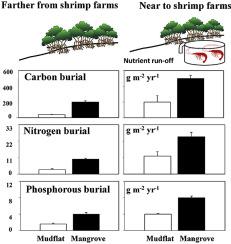Estuarine, Coastal and Shelf Science ( IF 2.8 ) Pub Date : 2020-07-03 , DOI: 10.1016/j.ecss.2020.106879 Alexander Pérez , Wilson Machado , Dimitri Gutiérrez , Maritza S. Saldarriaga , Christian J. Sanders

|
In order to investigate the influence of shrimp farming activities on carbon and nutrient accumulation, sediment cores were collected from two areas at different distances from shrimp farms within a Peruvian mangrove ecosystem. In both areas two sediment cores were collected in a transect, one from a mangrove-covered site and one from a mudflat site. At both study sites, the isotopic values of carbon and nitrogen as well as the C:N molar ratios suggest that the highest carbon accumulation rates were linked to terrestrial-derived organic matter, with higher carbon stocks and fluxes within mangrove-covered zones. The historical records indicate that since the mid-1970′s, the areas nearest to the shrimp farming activity have been accumulating higher proportions of algal derived organic matter, which were likely triggered by the high nutrient influx derived from shrimp farming effluents. The carbon and nutrient fluxes were up to threefold higher within the area nearest to the shrimp farms, whereas the geochronologies showed that the carbon and nutrient stocks in this area increased by up to twofold. The results showed that mangrove-covered zones are more capable to keep pace with sea level rise (SLR) as compared to the mudflat zones, indicating the importance of mangrove vegetation in terms of the vulnerability of this region to SLR and an ongoing capacity to continue accumulating sediments. This study highlights the role that mangrove vegetation plays in mitigating the impact of shrimp farming activities, accumulating carbon and nutrients in pace with SLR.
中文翻译:

虾类养殖对秘鲁红树林沉积物中碳和养分积累的影响
为了调查虾类养殖活动对碳和养分积累的影响,从秘鲁红树林生态系统中距离虾类养殖场不同距离的两个地区收集了沉积物核心。在这两个地区,一个样地收集了两个沉积物核心,一个来自红树林覆盖的地点,另一个来自泥滩。在这两个研究地点,碳和氮的同位素值以及C:N摩尔比表明,最高的碳积累速率与陆生有机质有关,在红树林覆盖的区域内碳储量和通量较高。历史记录表明,自1970年代中期以来,最接近虾类养殖活动的地区积累了更多比例的藻类衍生有机物,这很可能是由虾类养殖废水中大量养分流入引起的。在最接近对虾养殖场的区域内,碳和养分通量最高增加了三倍,而根据年代学,该地区的碳和养分储量增加了两倍。结果表明,与滩涂区相比,红树林覆盖区更能跟上海平面上升(SLR)的步伐,这表明从该区域对SLR的脆弱性和持续能力而言,红树林植被的重要性堆积的沉积物。这项研究强调了红树林植被在减轻虾类养殖活动的影响,与SLR同步积累碳和养分方面所起的作用。在最接近对虾养殖场的区域内,碳和养分通量最高增加了三倍,而根据年代学,该地区的碳和养分储量增加了两倍。结果表明,与滩涂区相比,红树林覆盖区更能跟上海平面上升(SLR)的步伐,这表明从该区域对SLR的脆弱性和持续能力而言,红树林植被的重要性堆积的沉积物。这项研究强调了红树林植被在减轻虾类养殖活动的影响,与SLR同步积累碳和养分方面所起的作用。在最接近对虾养殖场的区域内,碳和养分通量最高增加了三倍,而根据年代学,该地区的碳和养分储量增加了两倍。结果表明,与滩涂区相比,红树林覆盖区更能跟上海平面上升(SLR)的步伐,这表明从该地区对SLR的脆弱性和持续能力而言,红树林植被的重要性堆积的沉积物。这项研究强调了红树林植被在减轻虾类养殖活动的影响,与SLR同步积累碳和养分方面所起的作用。结果表明,与滩涂区相比,红树林覆盖区更能跟上海平面上升(SLR)的步伐,这表明从该区域对SLR的脆弱性和持续能力而言,红树林植被的重要性堆积的沉积物。这项研究强调了红树林植被在减轻虾类养殖活动的影响,与SLR同步积累碳和养分方面所起的作用。结果表明,与滩涂区相比,红树林覆盖区更能跟上海平面上升(SLR)的步伐,这表明从该地区对SLR的脆弱性和持续能力而言,红树林植被的重要性堆积的沉积物。这项研究强调了红树林植被在减轻虾类养殖活动的影响,与SLR同步积累碳和养分方面所起的作用。


























 京公网安备 11010802027423号
京公网安备 11010802027423号